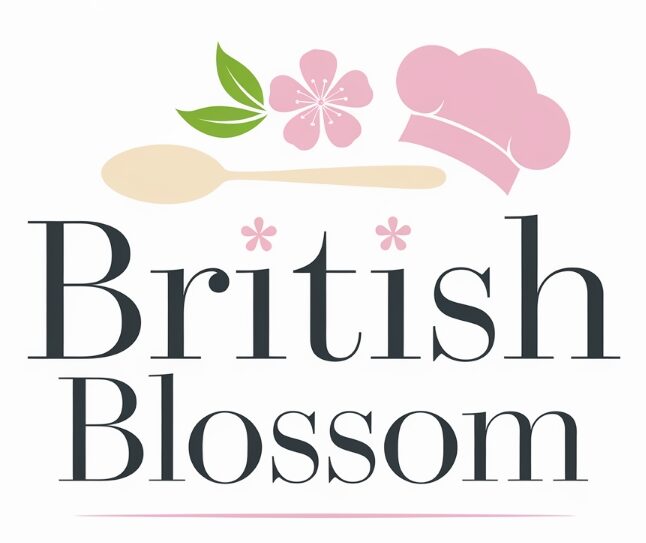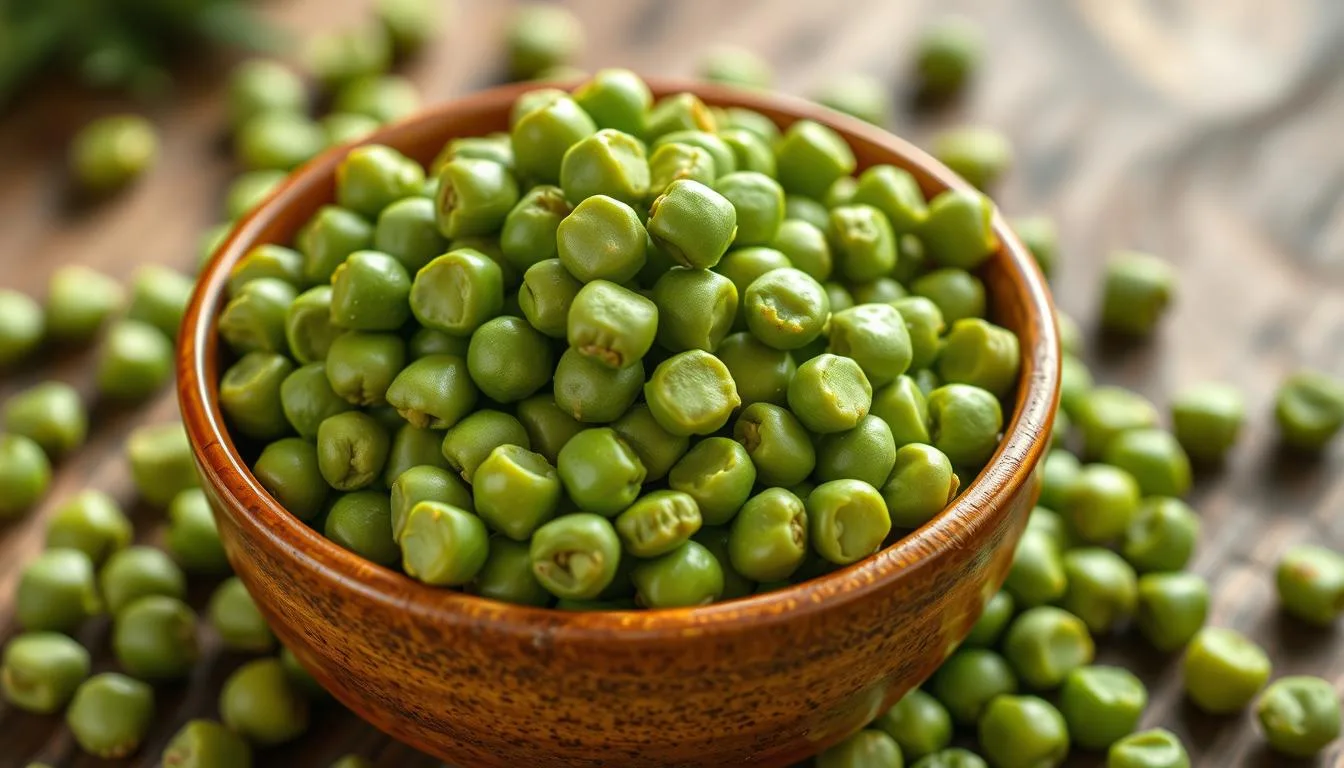Have you tried wasabi peas? They’re a Japanese snack that’s loved worldwide. Imagine a roasted pea covered in spicy wasabi powder. It’s a flavor that grabs your attention and makes you want more.
So, what’s so special about these peas? Let’s find out.
Key Takeaways
- Wasabi peas, known as “wasabi mame” in Japan, are a popular crunchy snack made from marrowfat peas.
- These peas are roasted, coated in oil and wasabi powder, and offer an intense heat and addictive crunch.
- Wasabi peas contain 130 calories, 24 grams of carbs, and 130 mg of sodium per ounce, as well as iron, protein, and vitamins.
- The snack is enjoyed as a standalone treat or used in various recipes, from crunchy salmon dishes to salad toppings.
- Wasabi peas are described as addictive, though overconsumption can potentially damage taste buds.
Table of Contents
Introduction to Japanese-Inspired Crunchy Delights
In Japan, snacks are a big part of the culture. Senbei (rice crackers) and Pocky (flavored biscuit sticks) are favorites. Wasabi peas, with their spice and crunch, are loved by many.
The Origin of Wasabi Mame in Japanese Culture
Wasabi peas, or “wasabi mame,” come from Japan’s rich food traditions. Wasabi, a spicy condiment, is key in sushi and ramen. It’s no wonder they made a snack that’s both spicy and crunchy.
Why These Spicy Treats Gained Global Popularity
Wasabi peas are now loved around the world. They mix wasabi’s heat with green peas’ sweetness. This mix excites those who love bold flavors.
As people try new foods, wasabi peas stand out. They offer a spicy, crunchy snack that’s different from usual treats. This meets the desire for exciting flavors.
What Makes Wasabi Peas So Uniquely Addictive
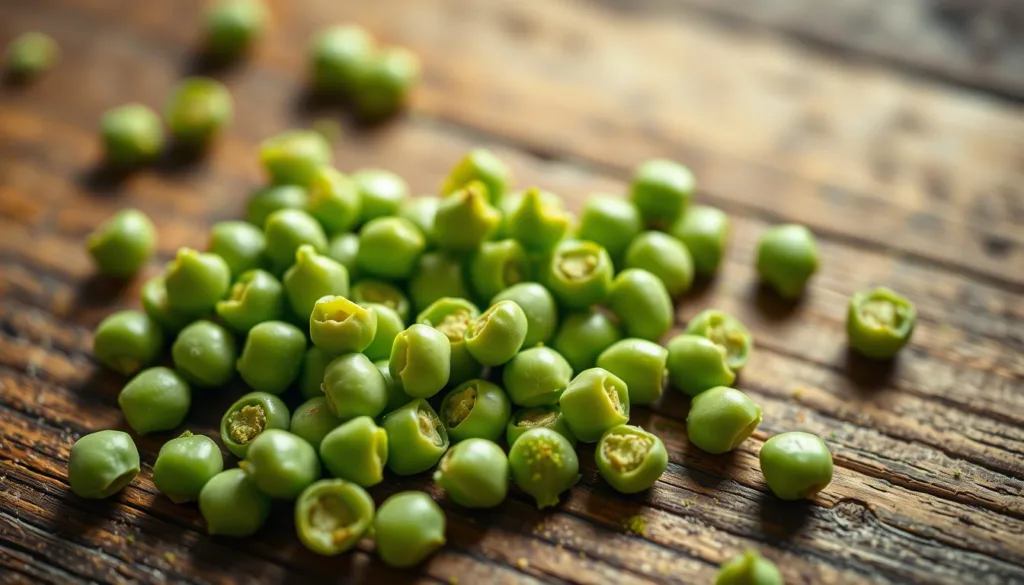
Wasabi peas are a snack that people love all over the world. They are spicy and crunchy. This mix of flavors and textures is very addictive.
The heat of wasabi peas is a big part of their charm. Some are so spicy, they can make your eyes water.
The crunch of the peas is also key. It goes well with the spicy coating. This mix of heat and crunch makes wasabi peas special.
Wasabi peas can also change how you taste things. Eating a whole bag can make your taste buds different. This makes them even more appealing.
In short, wasabi peas are addictive because of their heat, crunch, and effect on taste. It’s easy to see why they’re a favorite snack globally.
The Art of Making Wasabi-Coated Green Peas
Making wasabi-coated green peas is a true art. They use special peas called marrowfat peas. First, these peas are roasted for crunch. Then, they’re coated in a mix of oils and wasabi powder.
Traditional Preparation Methods
In Japan, making wasabi peas is a big deal. They use real wasabi root for a strong flavor. Some brands use imitation wasabi for a similar taste.
Key Ingredients and Coating Process
The secret to tasty wasabi peas is in the mix. They use peanut or vegetable oil and wasabi powder. This mix gives the peas a bright green color and a unique taste.
The Role of Marrowfat Peas
Marrowfat peas are the main ingredient. They give the peas a crunchy texture. This texture is perfect for the spicy wasabi coating.
| Ingredient | Quantity |
|---|---|
| Marrowfat Peas | 1 cup |
| Peanut Oil | 2 tablespoons |
| Wasabi Powder | 1 tablespoon |
| Salt | 1/4 teaspoon |
This table shows what you need to make wasabi peas at home. The mix of marrowfat peas, peanut oil, and wasabi powder makes a tasty snack.
Nutritional Profile and Health Benefits
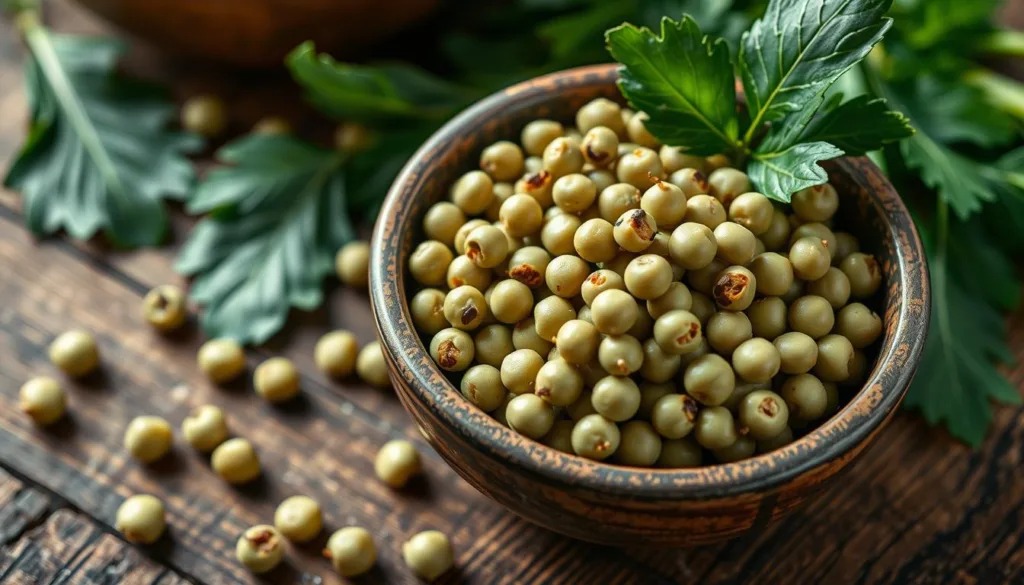
Wasabi peas are packed with nutrients. A 1-ounce serving has 121 calories, 17.5 grams of carbs, and 4 grams of sugar. They also have 4 grams of protein, 4 grams of fat, and 1 gram of fiber.
These peas are full of vitamins and minerals. They have manganese, thiamin, copper, and vitamin K. They also have folate, niacin, vitamin B6, and zinc.
The manganese in wasabi peas is very important. It has antioxidant properties. The peas also have antioxidants like ellagic acid and quercetin. These help fight oxidative damage.
| Nutrient | Amount per 1 oz (28g) Serving | % Daily Value |
|---|---|---|
| Calories | 121 | – |
| Total Carbs | 17.5 g | – |
| Sugar | 4 g | – |
| Protein | 4 g | – |
| Total Fat | 4 g | – |
| Fiber | 1 g | – |
| Manganese | – | 15% |
| Thiamin | – | 14% |
| Copper | – | 14% |
| Vitamin K | – | 12% |
Wasabi peas are not low in calories, but they can fit into a balanced diet. They have protein and fiber to help control blood sugar. Manganese in them may also lower diabetes risk.
But, some wasabi peas may have added sugars, sodium, or antinutrients. This could be bad for some people. Always check the labels and think about your diet before eating them.
Understanding the Heat Factor of Wasabi Snacks
Spicy peas and wasabi snacks are all about the heat. The wasabi kick can vary a lot. It’s important to know how spicy they are before you try them.
Measuring the Spiciness Level
The heat of wasabi is measured on the Scoville Heat Unit (SHU) scale. Real wasabi plants from Japan are rare. So, horseradish is often used instead.
Real wasabi is between 2,500 SHU to 8,000 SHU. But, horseradish-based snacks can be up to 10,000 SHU. This is as hot as a jalapeño.
Habanero peppers are much hotter, from 100,000 SHU to 350,000 SHU. Ghost peppers are even hotter, from 850,000 SHU to 1,040,000 SHU. The Carolina Reaper is the hottest, from 1,600,000 SHU to 2,200,000 SHU. Wasabi snacks are milder compared to these.
Managing the Wasabi Kick
Wasabi’s intense heat can help with eating less. It makes you feel the burn for a long time. Drinking water and eating slowly can make it more enjoyable.
| Pepper Variety | Scoville Heat Units (SHU) |
|---|---|
| Genuine Wasabi | 2,500 – 8,000 SHU |
| Horseradish-based Wasabi | Up to 10,000 SHU |
| Jalapeño Peppers | 2,500 – 8,000 SHU |
| Habanero Peppers | 100,000 – 350,000 SHU |
| Ghost Peppers | 850,000 – 1,040,000 SHU |
| Carolina Reaper | 1,600,000 – 2,200,000 SHU |
Dietary Considerations and Restrictions
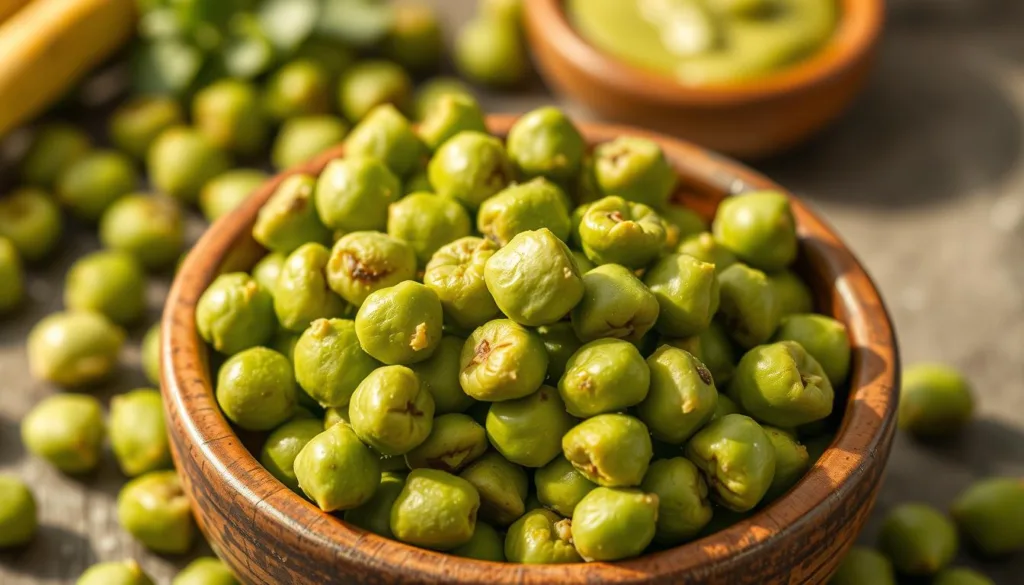
Enjoying wasabi peas requires knowing about dietary rules. These tasty treats are inspired by Japan. But, their ingredients might not be good for everyone.
Wasabi peas are okay for vegetarians and vegans. But, they might have wheat, gluten, and soy.
For those on the Whole30 diet, wasabi peas are something to think about. Peas, like those in wasabi peas, are usually okay for Whole30. This is because of research and advice from doctors.
Wasabi peas have about 100-150 milligrams of sodium per serving. This is a lot of sodium. People who are sensitive to salt should watch how much wasabi peas they eat.
Even with these points, wasabi peas might be good for you. They have compounds that could help fight inflammation and cancer. But, remember to eat them in small amounts and watch out for spiciness and allergies.
In short, wasabi peas are good for many diets. But, it’s important to think about your own diet, allergies, and health. Knowing what’s in wasabi peas helps you decide if they’re right for you.
Perfect Pairing Suggestions for Wasabi Peas
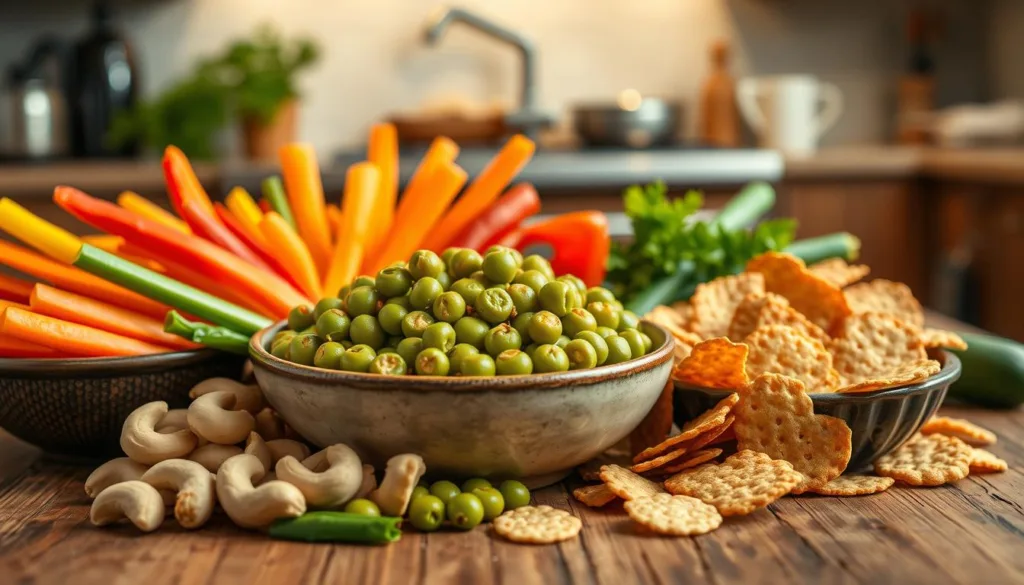
Wasabi peas are a hit with their bold Japanese flavors. They go great with many drinks.
Beverage Combinations
Wasabi peas and sake are a perfect match. The cool sake balances the wasabi’s heat. This mix is full of flavor.
Beer fans will love wasabi peas with IPA or stout. The beer’s bitterness meets the peas’ spice.
For those who don’t drink alcohol, try lemon-lime soda. It’s refreshing and cool. Or, just water. It’s pure and cleanses your taste buds.
Snack Mix Ideas
- Add wasabi peas to your trail mix for a fun twist.
- Make a mix with wasabi peas, almonds, cashews, and cranberries. It’s sweet, salty, and spicy.
- Try a Japanese mix with wasabi peas, sesame seeds, seaweed, and edamame.
Wasabi peas are great in many snack mixes. They add flavor, texture, and a kick.
| Beverage Pairing | Flavor Profile |
|---|---|
| Sake | The cool, crisp notes of sake balance the intense heat of wasabi peas, creating a harmonious flavor experience. |
| IPA | The hoppy bitterness of an IPA complements the spicy kick of wasabi peas, making for a refreshing and invigorating pairing. |
| Lemon-lime Soda | The carbonation and citrusy tang of a lemon-lime soda provide a cooling contrast to the heat of the wasabi peas. |
Creative Culinary Applications in Modern Cooking
Wasabi peas are now used in many modern dishes. They add a spicy kick to both savory and sweet foods. This lets chefs try new flavors and textures.
One cool way to use wasabi peas is as a crunchy coating for fish or chicken. The recipe uses 2 cups of wasabi peas. It makes the dish look and taste great, with a nice heat and nuttiness.
Wasabi peas also make salads crunchier and spicier. A recipe in “The Martha Stewart Living Cookbook” mixes them with sugar snap and snow peas. It’s a fresh and colorful side dish or starter.
Wasabi peas can even be used in desserts. A wasabi pea brittle is a sweet and spicy treat. It’s made with 6 disks of goat cheese, wasabi peas, and 3/4 cup of olive oil. It serves 6 people.
Wasabi peas are a hit in modern fusion cooking. Chefs mix Japanese flavors with Western cooking. As they get more popular, we’ll see even more creative uses in cooking.
| Ingredient | Quantity |
|---|---|
| Wasabi peas | 2 cups |
| Fresh goat cheese | 12 oz (6 1-inch-thick disks) |
| Extra-virgin olive oil | 3/4 cup |
| Sugar snap peas | 5 oz, blanched |
| Snow peas | 5 oz, blanched |
| Servings | 6 |
Storage Tips and Shelf Life
Keeping wasabi peas fresh and crunchy is key. They should be stored properly to enjoy their unique taste and texture. Unopened wasabi peas can last up to a year in a cool, dry spot away from sunlight.
After opening, move the peas to an airtight container or bag. This way, they can stay fresh for about 6 months. Store them at a temperature between 5-10 degrees Celsius (41-50 degrees Fahrenheit) for the best crunch.
Maintaining Freshness
Keep wasabi peas in a low-humidity place to prevent them from losing crunch. High humidity, around 90%, can make them lose their crispiness. Look for a consistent green color. Any color change means they might be spoiled. Freezing is not good as it changes their texture and taste.
Packaging Options
- Resealable bags or containers are great for storing opened wasabi peas, keeping them fresh.
- Airtight jars or canisters also work well, keeping air out.
- Check the expiration date to enjoy them at their best.
By following these tips, you can enjoy wasabi peas for weeks or months.
Portion Control and Serving Suggestions
Enjoying wasabi peas or spicy peas means watching your portion size. A good serving is about one ounce (28 grams). Their strong taste makes it wise to start with a small amount, as most can’t handle more than 10 peas.
The heat and flavor of wasabi peas can be too much. So, it’s smart to adjust how much you eat based on your taste. This way, you enjoy them more and avoid feeling overwhelmed.
| Nutrient | Amount per Serving |
|---|---|
| Calories | 100-150 |
| Sodium | 100-150 mg |
| Protein | 4 g |
| Carbohydrates | 11 g |
| Fat | 2 g |
Wasabi peas are tasty but high in calories because of drying. They also have some sodium. So, people watching their diet should eat them in moderation.
To eat wasabi peas healthily, mix them with other snacks or fruits and veggies. This balances their strong taste and calories. By controlling portions and knowing your limits, you can enjoy these snacks without overdoing it.
Comparing Different Brands and Varieties
I love trying new snacks, and wasabi peas are a favorite. They come from Japan and are crunchy and spicy. I find them irresistible.
When I compare wasabi peas, I notice the heat levels vary. Medley Hills Farm uses real wasabi for a strong kick. Blue Diamond Almonds has a milder flavor. It’s fun to find the perfect spice for you.
The texture of wasabi peas also changes. Sincerely Nuts has a classic crunchy coating. Other brands try new coatings for extra flavor.
- gimMe offers organic seaweed wasabi snacks for a twist.
- Medley Hills Farm has hot wasabi peas with real wasabi flavor.
- Blue Diamond Almonds has a wasabi and soy sauce snack mix.
- Sincerely Nuts sells bulk wasabi peas for a mineral boost.
Trying new wasabi peas is exciting. You can find ones that are just a little spicy or very bold. There’s a perfect match for everyone.
Shopping Guide: Where to Find Quality Wasabi Peas
I love crunchy snacks, and wasabi peas are a favorite. This guide will help you find the best wasabi peas for a spicy treat or new Japanese snacks.
Online Shopping Options
Online shopping is easy for wasabi peas. You can find them on many websites. Here are some top places:
- Amazon: Offers many wasabi pea brands, from 22-ounce bags to bulk sizes.
- Specialty Food Websites: Nuts.com and GourmetFoodWorld.com sell high-quality wasabi peas.
- Asian Grocery Stores Online: H Mart and Uwajimaya have authentic Japanese wasabi peas.
Store Recommendations
Shopping in person is fun too. Here are places to find great wasabi peas:
- Asian Grocery Stores: These stores have lots of wasabi peas, including Japanese brands.
- Specialty Food Shops: Gourmet and health food stores, and some supermarkets, sell premium wasabi peas.
- Wholesale Clubs: Costco and Sam’s Club have big bags of wasabi peas for regular eaters.
When buying wasabi peas, look at the brand, ingredients, and reviews. This ensures you get what you want. With some searching, you’ll find the best wasabi peas for your snacking needs.
The Rise of Wasabi Peas in American Snack Culture
More Americans want bold, international flavors in their snacks. Wasabi peas, with their Japanese wasabi kick, are now a hit. They offer a new twist on traditional snacks.
The history of wasabi peas in Japan is rich. They started as a snack and now excite adventurous eaters in the U.S. The wasabi flavor, from the Wasabia Japonica plant, is bold and memorable.
Wasabi peas are not just tasty; they’re also nutritious. A 100-gram serving has 430 calories, 4 grams of protein, and lots of fiber. They’re a healthy, filling snack option.
The love for wasabi peas also comes from Japanese snack culture’s growing popularity in the U.S. Online stores and specialty shops make it easy to find these snacks. Japanese snack boxes, with both classic and new flavors, add to the excitement.
Brands like L’Orenta Nuts are now big names in wasabi peas. They have SQF, HACCP, GMP, and FDA approvals. This ensures top-notch quality and safety for American consumers.
In summary, wasabi peas are a big hit in the U.S. They show how health-conscious people want bold, international tastes. As Japanese food and culture grow in popularity, wasabi peas are here to stay, delighting Americans everywhere.
| Nutritional Facts | Amount per 100g |
|---|---|
| Calories | 430 g |
| Protein | 4 g |
| Fiber | Over 1 oz |
| Carbohydrates | 16 g |
Conclusion
Wasabi peas are a world of delight, combining crunch and spice. They have won many hearts, including mine. Their flavors and uses make them a favorite snack.
But, we should eat them in small amounts because of calories and sodium. Yet, their bold taste makes them great for trying new things. You can enjoy them with drinks or in many dishes.
Ending this journey, I appreciate wasabi peas even more. They mix old traditions with new ideas. If you love them or are just starting, keep exploring. Try new things and enjoy the special taste of wasabi peas.
